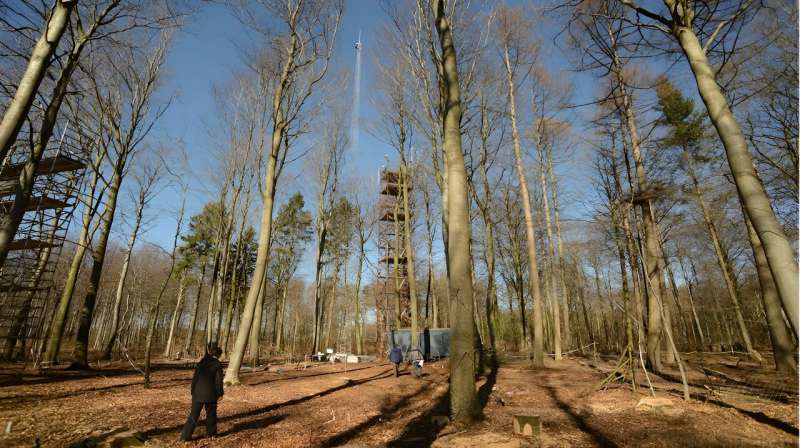This article has been reviewed according to Science X's editorial process and policies. Editors have highlighted the following attributes while ensuring the content's credibility:
fact-checked
trusted source
proofread
Beech forests are beneficial in the climate crisis but suffer under drought and heat

Measurements from the past 27 years show that nature's ecosystem services and good biodiversity remove CO2 from the atmosphere, thus reducing the effect of carbon emissions. However, it is also clear that ecosystem services are affected by higher temperatures and drought, i.e., climate change.
Biodiversity is not only about species and statistics—it is also about the ecosystems that host the animals and plants. Ecosystems not only serve as habitats but also provide ecosystem services that help humans, such as oxygen and food production through photosynthesis.
In a beech forest near Sorø, DTU has been measuring more than 100 different parameters since 1996. The measurements are made every half hour and are primarily related to the exchange of carbon dioxide between the ecosystem (the forest) and the atmosphere.
When reviewing data from the first 24 years up to 2019, the observations show that the beech forest has increased its carbon uptake through the years, thus helping to reduce the climate crisis. Net carbon uptake happens during the summer, when the trees have leaves. In the winter, the forest releases carbon instead.
"One of the causes of the increased uptake is the climate changes we're experiencing. The warmer weather leads to changes in the trees' carbon uptake. It doesn't happen much in spring, where it's the amount of light and the length of the day that determines when the beech leaves sprout, and thus when the carbon uptake in connection with photosynthesis begins," says Kim Pilegaard, Professor Emeritus, DTU Sustain.
Over the 24 years, the timing of the beech leaves sprouting has moved forward a little less than six days in total.
"Furthermore, we can see that due to the higher temperatures, the trees retain their leaves even longer in the autumn. Thus, their carbon uptake also continues for a longer period, 13 days in total, which increases the total amount," says Pilegaard.
Drought and heat have negative effects
The long data series from the measurements in Sorø enables the researchers to determine what a normal year looks like and to track the development over the years and the changes in years with extreme weather.
"The very hot and dry summer of 2018 clearly affected the readings. In the spring of 2018, the trees' carbon uptake was large because they thrived on the light and heat. But later in the summer, when the drought began and not even the trees' long roots could give them water, their intake dropped drastically," explains Andreas Ibrom, Associate Professor at DTU Sustain.
The forest's total carbon uptake in 2018 was reduced by around 25%, and during the driest months in the late summer, the uptake was reduced by up to 50% compared to previous years.
"We haven't processed the data from this year yet, but my guess is that the numbers won't differ much from the normal level. Although the early summer of 2023 was both hot and dry, the rain came in July, and the trees likely didn't lack water before then. In terms of water, the length of their roots gives them a clear advantage over other plants," says Andreas Ibrom.
A good biodiversity with a stable and healthy ecosystem can withstand one year of extreme weather and bounce back to provide the same ecosystem services as before. However, scientists do not know how the ecosystems will react if they are exposed to extreme weather for several years in a row.
The measuring station in Sorø
- The measuring station in the beech forest in Sorø is the third-longest serving station in the world, surpassed only by stations in Massachusetts and Sweden.
- The measurements of the exchange of carbon dioxide between the ecosystem and the atmosphere are made every half hour. Other factors such as humidity, temperature, wind speed, radiation, soil water content, soil temperature, etc. are also measured, all of which have an impact on the ecosystem and its services.
- All the data is available to the public and is downloaded three times a day, on average. The data is used by scientists from all over the world for analyses, modeling, etc.
- The long data series is invaluable to the research, as it would be impossible to detect the changes, e.g., in connection with the 2018 drought, without data from the previous years for comparison.
Provided by Technical University of Denmark





















